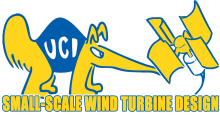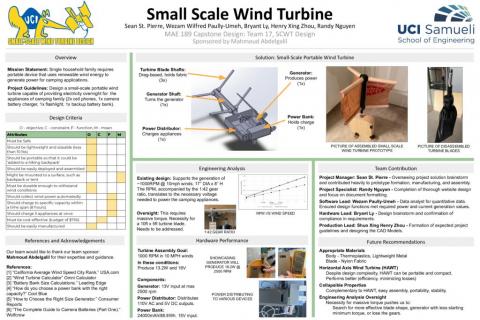Small Scale Wind Turbine
Background
Dependence on electricity brought forth a necessity for fossil fuels. Widely associated, pollutants and non-renewability make for a great deal of negatives. Fossil fuels are finite resources that emits excess pollutants that further speed up the process of climate change. And, potentially more niche, the demand of being connected to a grid system to access the electric energy makes for a great deal of inconvenience.
Though, the small-scale portable wind turbine offers solutions dealing with all of the aforementioned issues. The turbine converts casual wind into enough usuable energy to power a single household. Wind, being a casual resource, disconnects you from worries of accessibility and dependences. By harnessing wind power and thus storing electricity for future applications, there are no greenhouse gases or pollutant byproducts that will be released into the surrounding environment.
Goal and Objectives
Our team aims to design a small-scale portable wind turbine that is uniquely portable, functional, and cost-effective. As for the purpose, the wind turbine is intended to be used by a small camping family to charge two cellphones, a camera battery charger, a flashlight, and a backup battery bank on one charge. As per design specifics, the turbine would be easily assemblable by 2 or less people. Specifically, the machine is required to be mobile and to fit inside or hang outside of a typical camping bag. Regarding functionality, the wind turbine would harness wind and convert it into the minimal energy necessary for the charging of the five total devices. The electricity must being generated overnight.
As design is mainly considered, a wind turbine is still expected to be constructed and assembled within a $750 budget. The manufacturing phase will begin starting Week 7 and the prototype is required to show proof of concept of harnessing enough wind and thus energy power to charge the five listed appliances,
Goals
- (Week 2) Establishing team and team member responsbilities
- (Week 3) Conclude design decisions
- (Week 4) Have a working Bill of Materials and calculate properties regarding efficiency and performance
- (Week 5) Be ready to share current design in Midterm Presentation to sponsor
- (Week 6) Assemble CAD Models (Solidworks) and confirm costs
- (Week 7-10) Carry out Manufacturing Phase with working model that exhibits proof of concept
Major Design Decision
Mainly, when considering major design choices for wind turbines, a largely important decision needs to be made between the orientation of horizontal or vertical-axis turbine blades. Horizontal Axis Wind Turbines are considered to be more efficient and reliable due to its height, which in turn produces more power and results in less turbulent wind flow. On the other hand, Vertical Axis Wind Turbines are easier to produce, repair, and store due to its lower hieght. Because of it's orientation, it is also able to function in extreme weather where there are variable winds. Despite members gravitating towards a horizontal orientation as they are more widely available, our team figured aligning the small-scale wind turbine's axis vertically would be more suitable for meeting the specific requirements of the project.
As a reminder, the objective regards portability. Our team found it that a horizontal-axis turbine complicates any potential assembly, in turn, hindering portability. Though, the verticality remains symmetrical, proving to be a design benefit in its ability to be carried. Additionally, the vertical property enables wind energy collection from any direction, thereby eliminating any user complications for overnight charging. Finally, we also decided that it would be easier to develop a mesh or shell that encases the turbine blades in the vertical axis orientation opposed to the horizontal axis to protect birds, insects, and small animals from getting injured.These advantages made it clear to our team that despite the differing efficiencies, the vertical axis proves to be appropriate for our design objectives.
Team Contacts
Sean St. Pierre (stpierre@uci.edu)
Wezam Paully-Umeh (wpaullyu@uci.edu)
Bryant Ly (bryantgl@uci.edu)
Shuo Xing Zhou [Henry] (sxzhou@uci.edu)
Randy Nguyen (randyn5@uci.edu)
Sponsor/Advisor
Mahmoud Abdelgalil (maabdelg@uci.edu)
Midterm Presentation
https://docs.google.com/presentation/d/1GGFqwxHE0H1my3lsNYDIQe6oNYKmIYdphQePKz0LNL4/edit


